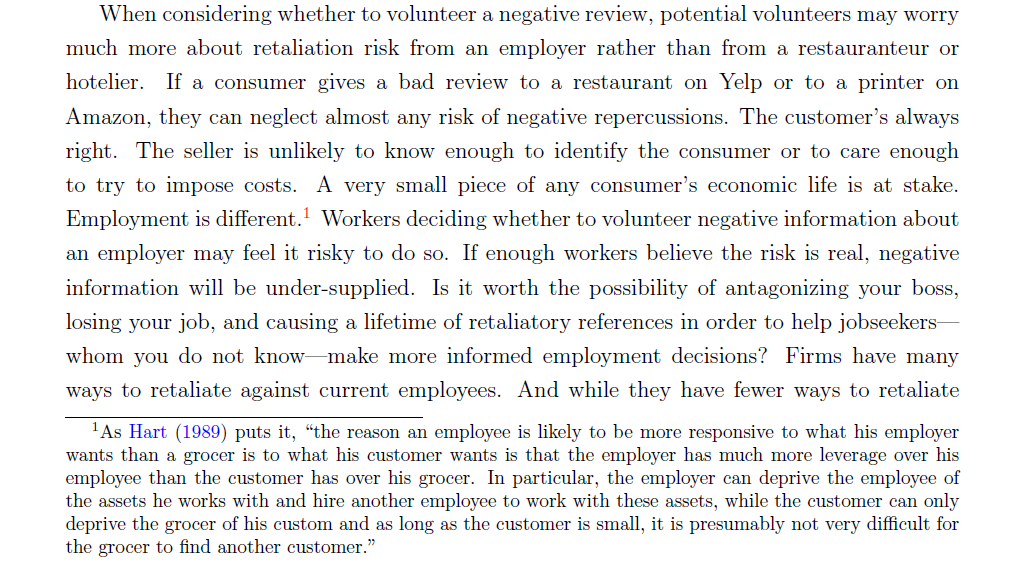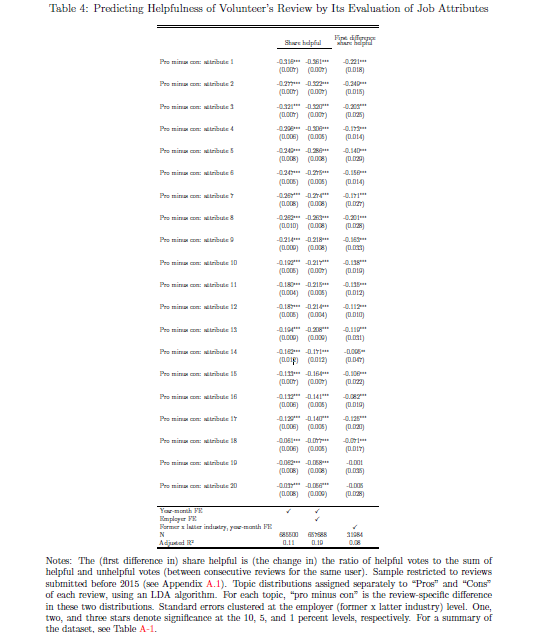🎉Updated paper w/Jason Sockin 🎉
Jobseekers struggle to understand attributes of potential employers.
Current & former employees have inside scoop but weak incentive to supply voluntarily, face retaliation risks.
Strong demand for neg info. papers.ssrn.com/sol3/papers.cf…
Jobseekers struggle to understand attributes of potential employers.
Current & former employees have inside scoop but weak incentive to supply voluntarily, face retaliation risks.
Strong demand for neg info. papers.ssrn.com/sol3/papers.cf…

Because a job is so central to one's well-being and various forces make jobs hard to replace, risks are higher when leaving a negative review of your employer than a restaurateur or hotelier. 

Employers can and often do use discourage current & former employees from surfacing negative information.
For instance, over 1/3 US workers report being bound by nondisclosure clauses (per @evanpstarr), which bleed into nondisparagement & lawsuit risk (@OrlyLobel).
For instance, over 1/3 US workers report being bound by nondisclosure clauses (per @evanpstarr), which bleed into nondisparagement & lawsuit risk (@OrlyLobel).
An employer has a strong interest in suppressing the info.
#MeToo
nytimes.com/2020/03/02/bus…
#OSHA
bloomberg.com/news/features/…
But those with interests in info coming out -- prospective employees, competing firms, & enforcement agencies -- don't coordinate to countervail these risks
#MeToo
nytimes.com/2020/03/02/bus…
#OSHA
bloomberg.com/news/features/…
But those with interests in info coming out -- prospective employees, competing firms, & enforcement agencies -- don't coordinate to countervail these risks
A 1979 book @WKipViscusi offers a model of worker learning. His+O'Connor 1984 AER paper surveyed workers on their beliefs abt workplace hazards & did more.
jstor.org/stable/554
But flow of info to workers about job attributes has been hard to observe & research. More to do!
jstor.org/stable/554
But flow of info to workers about job attributes has been hard to observe & research. More to do!
We look an institution designed to facilitate the flow of info: @Glassdoor.
Finding 1: volunteers are more likely to conceal aspects of their identity when reporting more negative info, esp where retaliation risk should be higher, smaller firms & for current employees.
Finding 1: volunteers are more likely to conceal aspects of their identity when reporting more negative info, esp where retaliation risk should be higher, smaller firms & for current employees.

But Catch-22!
Finding 2: Volunteers' identity concealment reduces value of info to jobseekers (last column), plausibly because not knowing volunteer's job title or location makes it harder for the jobseeker to judge the relevance of the info to their own situation.
Finding 2: Volunteers' identity concealment reduces value of info to jobseekers (last column), plausibly because not knowing volunteer's job title or location makes it harder for the jobseeker to judge the relevance of the info to their own situation.

This is consistent with prior evidence @mioana & coauthors that the marginal review is more negative than the average review, that unreported potential reviews skew negative.
journals.aom.org/doi/abs/10.546…
journals.aom.org/doi/abs/10.546…
Finding 3: jobseekers are much more likely to vote negative info as helpful than positive info. Simple evidence:
Abt 40% of jobseekers' helpful votes are on 1-star reviews.
Abt 40% of unhelpful votes are on 5-star reviews.
This doesn't tend to be true w/consumer reviews
Abt 40% of jobseekers' helpful votes are on 1-star reviews.
Abt 40% of unhelpful votes are on 5-star reviews.
This doesn't tend to be true w/consumer reviews

This finding is super-robust. It holds across firm age (graph), # of prior reviews, average overall rating, wage premium & controlling for lots of things.
It holds using other uni-dimensional measures of review positive/neg content, e.g. would you recommend employer to a friend.
It holds using other uni-dimensional measures of review positive/neg content, e.g. would you recommend employer to a friend.

Finding 4: demand for negative info holds across every job attribute.
We model latent attributes in review text. Difference in how much each review focuses on each attribute in the Pros field - in Cons field = positivity of info.
On every attribute: positive <=> unhelpful.
We model latent attributes in review text. Difference in how much each review focuses on each attribute in the Pros field - in Cons field = positivity of info.
On every attribute: positive <=> unhelpful.

Finding 5: letting helpfulness depend on horizontally-differentiating info doesn't change helpfulness of vertically-differentiating info.
Some jobseekers review own employer. Correlation btwn attributes they discuss & what a review discusses ⬆️chance helpful & basic result stays
Some jobseekers review own employer. Correlation btwn attributes they discuss & what a review discusses ⬆️chance helpful & basic result stays

Finding 6: job attributes have similar relative magnitudes in explaining both:
a) jobseeker evaluation of reviews' helpfulness, &
b) volunteer evaluations of their own job satisfaction (in models like @NicoleMaestas2 @TillvonWachter @thedavidpowell or Mas & Pallais).
a) jobseeker evaluation of reviews' helpfulness, &
b) volunteer evaluations of their own job satisfaction (in models like @NicoleMaestas2 @TillvonWachter @thedavidpowell or Mas & Pallais).

Finding 7: supply & demand for info aren't well aligned.
Relative importance of attributes to workers in terms info demand is only loosely (0.20) correlated with their relative supply.
Most-demanded 10 attributes account for 66% of demand weight but only half of supply weight.
Relative importance of attributes to workers in terms info demand is only loosely (0.20) correlated with their relative supply.
Most-demanded 10 attributes account for 66% of demand weight but only half of supply weight.

In sum, jobs largely experience goods (Menzio & Shi). Supply & demand for job attribute info all long tails, no mass market.
Worry about retaliation risk may be to blame for under-supply of negative info.
Addressing workers' information problems may improve efficiency.
Worry about retaliation risk may be to blame for under-supply of negative info.
Addressing workers' information problems may improve efficiency.
Excited to present this on Friday at the "Matching Workers & Jobs Online" conference at IDSC @iza_bonn @uni_lu.
conference.iza.org/conference_fil…
Feedback very welcome!
conference.iza.org/conference_fil…
Feedback very welcome!
• • •
Missing some Tweet in this thread? You can try to
force a refresh










